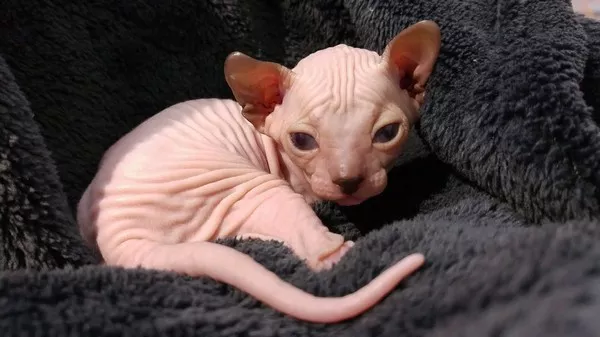Sphynx cats are one of the most distinctive and recognizable cat breeds, known primarily for their hairless appearance. Despite their lack of a traditional fur coat, these cats have captured the hearts of many with their unique look and affectionate nature. However, for individuals with cat allergies, the question arises: Are Sphynx cats a suitable option? This article explores the characteristics and living habits of Sphynx cats while examining whether Sphynx Cats are good for people allergic to cats.
Characteristics of Sphynx Cats
Physical Features
The Sphynx cat‘s most notable feature is its lack of a full fur coat. Instead of a traditional coat, Sphynx cats have a fine layer of down or fuzz on their skin, giving them a distinctive, almost velvety texture. Their skin is often described as warm and smooth to the touch, and they are known for their prominent wrinkles and large ears. The absence of a full fur coat reveals their muscular build and striking appearance.
Personality and Behavior
Sphynx cats are renowned for their outgoing and affectionate nature. They are highly social and thrive on human interaction, often following their owners around and seeking constant companionship. Their playful and curious demeanor makes them entertaining pets, and they are known to form strong bonds with their families. Despite their lack of fur, Sphynx cats exhibit a range of behaviors and activities similar to other cat breeds, including playful antics and a love for interactive toys.
Living Habits of Sphynx Cats
Environmental Needs
Due to their hairless nature, Sphynx cats are sensitive to temperature fluctuations. They tend to feel the cold more acutely than other cats and may require extra warmth, especially in cooler climates. Providing cozy bedding, warm blankets, and heated cat beds can help ensure their comfort. Additionally, Sphynx cats enjoy basking in sunny spots and may seek out warm places in the home.
Diet and Nutrition
Like all cats, Sphynx cats require a balanced diet to maintain their health. A diet rich in high-quality protein and essential nutrients is crucial. Regular feeding schedules and portion control help in managing their weight and overall health. Consulting with a veterinarian to tailor the diet to the specific needs of a Sphynx cat is recommended.
See Also: How Often Should You Bathe a Sphynx Cat?
Grooming and Hygiene
One of the unique aspects of caring for a Sphynx cat is its grooming needs. Despite their lack of fur, Sphynx cats produce more skin oils, which can accumulate and lead to oily residue on their skin. Regular baths are necessary to remove excess oils and prevent skin infections. In addition, their large ears require regular cleaning to prevent wax buildup and potential infections. Routine nail trimming and overall hygiene maintenance are also important aspects of caring for a Sphynx cat.
Allergies and Sphynx Cats
Understanding Cat Allergies
Cat allergies are typically triggered by proteins found in cat dander, saliva, and urine. These proteins can become airborne and cause allergic reactions in sensitive individuals. The most common allergen is Fel d 1, a protein produced by cat saliva and sebaceous glands. This protein is present in cat skin flakes and can be a significant issue for those with allergies.
Sphynx Cats and Allergies
The Sphynx cat is often considered a potential option for individuals with cat allergies due to its lack of a full fur coat. The idea is that with less fur, there would be fewer dander particles floating in the air. However, it is essential to note that Sphynx cats still produce dander, although in potentially smaller amounts compared to furred cats. The absence of a full coat does not entirely eliminate allergens, but it may reduce the overall allergen load in the environment.
Scientific Studies and Evidence
Research on the allergen levels in Sphynx cats compared to other breeds is limited but suggests that the reduction in fur may lead to lower levels of airborne allergens. Some studies have found that Sphynx cats produce less Fel d 1 protein than their furred counterparts, which could contribute to a lower allergen presence. However, individual reactions can vary, and people with severe cat allergies might still experience symptoms even with a Sphynx cat.
Practical Considerations for Allergy Sufferers
If you are considering a Sphynx cat and have allergies, there are several practical steps you can take to minimize potential allergic reactions:
Allergen Management: Regular cleaning of the home, including vacuuming with HEPA filters and frequent washing of bedding and toys, can help reduce allergen levels.
Air Purifiers: Using air purifiers with HEPA filters can help remove allergens from the air.
Allergy Testing: Consult with an allergist to determine your specific sensitivities and whether a Sphynx cat might be a suitable option for you.
Trial Period: Spending time with a Sphynx cat before making a commitment can help gauge your reaction and determine if it is a viable option.
Conclusion
Sphynx cats offer a unique and intriguing alternative for individuals considering cat ownership, especially for those who are allergic to furred cats. Their hairless appearance and affectionate nature make them appealing pets, but it is important to recognize that they are not entirely hypoallergenic. While Sphynx cats may produce fewer allergens compared to other breeds, they still produce dander and other proteins that can trigger allergic reactions.
Understanding the characteristics and living habits of Sphynx cats is essential for potential owners. Their need for regular grooming, temperature management, and a balanced diet are key aspects of their care. For individuals with cat allergies, the Sphynx cat may offer a reduced allergen environment, but personal experiences can vary. Consulting with an allergist and taking practical steps to manage allergens can help determine if a Sphynx cat is a suitable choice for your household.
Ultimately, while Sphynx cats may provide a potential solution for allergy sufferers, it is crucial to consider all factors and make an informed decision based on individual needs and sensitivities.
Related Topics:
























